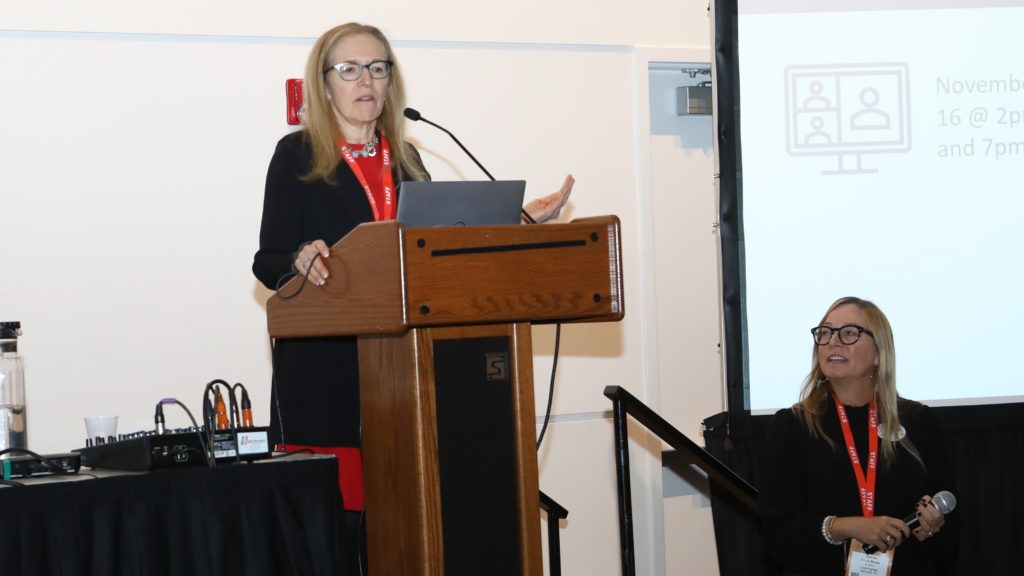
DENVER – One of the key changes to improving the quality of care in nursing homes is shifting the focus on what’s measured, said two Moving Forward Nursing Home Quality Coalition committee members Tuesday at the LeadingAge Annual Meeting and Expo.
Four members of the seven committees of the Moving Forward effort that sprang from the study released last spring by the National Academies of Science, Engineering, and Medicine identified their roles and visions for making nursing homes more important to the public and government. Moving Forward is convened by LeadingAge. The session was titled “Nursing Home Quality: Implementing the New NASEM Study.”
The landmark study recommended seven goals to improve nursing home quality.

Shifting focus on what is measured for quality ratings was at the forefront for Kim Bergen-Jackson, a member of the Quality Measurement and Continuous Quality Improvement committee. Bergen-Jackson is a retirement residence administrator and adjunct assistant professor at the University of Iowa College of Nursing and School of Social Work.
“I’m really interested in people’s thoughts on what we’re measuring and if it translates with validity,” she told McKnight’s Long-Term Care News. “We’ve already talked about the Five-Star rating system not always representing when quality care is occurring. I’m really interested in looking at what we’re measuring and I’m hopeful that we can try to make some changes.”
Better than believed?
Bergen-Jackson said that quality of life in particular can be addressed better.
“We may have residents with very complex health histories who require a ton of care but are living the life they want to based on the staff who take care of them,” she said. “I don’t think we capture that in any of our data right now. The measurement we use right now is very focused on quality of care and so it looks at very specific things, like pressure ulcers and urinary tract infections. I’m interested in looking at: How comfortable do you feel with the staff that take care of you? Do they ask you what matters most to you? Is anybody asking those questions? Is anyone listening to them?
“In my heart, I know they are and so how do we represent that so we can say without a doubt that people are living in a great place with great people and experiencing life the way they want to? We just really need to evaluate the system we have in place and look for barriers to providing the true scope of the care the person is receiving.”
The gathering of information that would make Bergen-Jackson’s ideas come to life is what Terry O’Malley is striving for. A retired geriatrician who worked primarily in nursing homes and taught at Harvard Medical School, O’Malley is co-chair of the Health Information Technology committee. He would like to ask different and more detailed questions of would-be residents without taxing staff.
“One of the difficulties in skilled nursing facilities is actually taking the time to figure out what a person’s goals and preferences are,” he told McKnight’s. “It’s very staff intensive. A minimum of an hour, and it’s probably several hours over several days to really get detailed goals and preferences that you really need, and that’s just impossible to do in the current structure.”
As a result, the workaround is that the nurse doing the admission assessment provides substituted judgment for what the goals and preferences are based on her understanding of the individual based on what they discussed, and that’s what gets fed into the care planning process, O’Malley said.
“We’re going to try to figure out what are the goals and preferences that we should be trying to ascertain,” he said. ‘There’s no master list of goals and preferences out there so we’ll have to build one. Once we know what they are, how do we get them in a way that’s really efficient for the staff, that doesn’t overburden the staff and yet ends up with a list of goals and preferences that give them a much richer picture of the individual which can then inform the care plan process?”
Once that problem is worked out, said O’Malley, the next project is to try to measure if the care plan is executed in concordance with the resident’s goals and preferences.
His initial idea is the resident and family would complete a questionnaire before the admissions process, answering all the new detailed questions about goals and preferences.
“Then the staff, instead of having to extract that information, they can review it and refine it,” he said. “It’s a huge change, but hopefully we’re going to make that possible with a huge decrease in staffing time. We cannot do anything that will take more staff time. We’re trying to give some back.”
The committees will each serve for two years by developing action plans for one to two NASEM recommendations, have the plans reviewed by stakeholders from across the nursing home sector, followed by testing of the plans.



